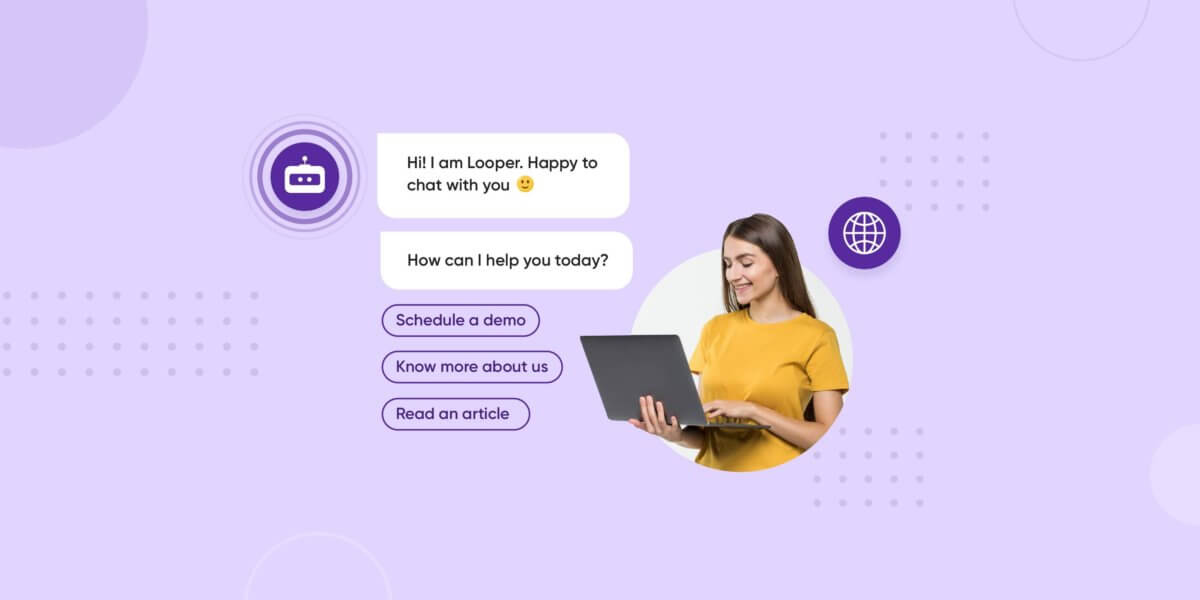5 Ways to Improve Sales Performance and Sales Pitch Overnight
- July 24th, 2025 / 6 Mins read
-
Aarti Nair

5 Ways to Improve Sales Performance and Sales Pitch Overnight
- July 24th, 2025 / 6 Mins read
-
Aarti Nair
Let’s be honest, selling isn’t what it used to be.
Today’s buyers are informed, impatient, and inundated with pitches that sound just like the last one.
Standing out?
That’s the real challenge.
You’ve probably felt it too. The deal that was “almost there” slips away. A pitch you thought nailed it… falls flat. And suddenly, the pressure to perform feels heavier than ever.
So here’s the question:
What if you could make noticeable improvements—not in a quarter, not next month—but by tomorrow morning?
Yes, overnight.
We’re not talking about vague mindset shifts or motivational fluff. We’re talking about practical, proven tweaks. Small changes that sharpen your pitch, boost your presence, and get prospects to say, “Tell me more.”
Whether you’re a seasoned rep or just starting to find your rhythm, these five strategies will help you cut through the noise, earn attention, and close with confidence.
Because sometimes, it’s not about working harder—it’s about working smarter, starting now.
In this blog post, we will talk about how to improve the sales performance of your company. And, improve your sales pitch overnight using the following measures.
The State of Sales in 2025: Why Your Old Pitch Isn’t Working
Let’s address the elephant in the (virtual) sales room.
Budgets are shrinking.
Teams are leaner.
And buyers? More cautious than ever.
The economic pressure of the past year has led to widespread budget cuts, departmental reshuffles, and ongoing layoffs across industries. CFOs are scrutinising every line item. CMOs are under pressure to justify ROI. And procurement? They’re taking longer than ever to say “yes.”
What does that mean for you?
It means the old way of selling—long-winded pitches, generic value props, vague promises—doesn’t just fall flat. It gets deleted.
The LLM Era: Buyers Don’t Wait for Your Pitch
Large Language Models (LLMs) and Gen AI have made information instant and everywhere. Buyers don’t wait for a rep to explain their product anymore—they’ve already:
-
Asked ChatGPT for the top 5 tools in your category
-
Read comparison blogs
-
Checked Reddit and G2 for unfiltered reviews
-
Watched explainer videos or user demos
By the time they land in your inbox or on your calendar, they know more than ever before. And if your pitch doesn’t add something new to the conversation, it’s irrelevant.
Gen AI: A Double-Edged Sword in Sales
Yes, AI has levelled the playing field. Reps can now churn out emails, call scripts, and sequences in minutes. But here’s the twist: so can everyone else.
And so… we’re now in a sea of sameness.
Buyers are hit with the same email frameworks. The same subject lines. The same AI-generated pleasantries.
They’re not just tuning out—they’re actively filtering you out.
The irony?
The more automated pitches become, the more buyers crave relevance and authenticity.
The Trust Deficit
B2B buyers today are more skeptical and risk-averse than ever. With pressure to justify every investment, they’re asking:
-
“Is this actually solving a problem we care about?”
-
“Will this show impact this quarter?”
-
“Is this rep telling me what I want to hear, or what I need to know?”
If your pitch doesn’t quickly earn trust, answer objections before they’re raised, and speak in their language, you’re out. So, in this high-stakes, AI-saturated, budget-tight environment, how do you actually sell better?
Let’s start with five fast, no-fluff ways to improve your sales performance overnight.
5 Ways to Improve Sales Performance Overnight
Let’s be honest—no one has time to wait three months for incremental gains when deals are stalling this week.
You need quick wins. Smart pivots. And strategies that work even in uncertain markets.
Because in 2025, sales isn’t just about how many dials you make or emails you send. It’s about how well you cut through the noise.
Here are five practical, zero-fluff ways to improve your sales performance by tomorrow morning—and yes, you can start tonight.
1. Show Up Where Your Buyers Already Are: LinkedIn
Before the cold email. Before the pitch.
There’s engagement. And that starts on LinkedIn.
Instead of jumping straight into DMs, start by adding value publicly:
-
Like and comment on your prospect’s posts (genuinely—no “great post!” fluff)
-
Re-share a post with your take on it
-
Join the conversations they’re already having
-
React to company updates, hiring posts, or press releases
Once you’ve built visibility and relevance, you’ve earned that DM. And when you send it, reference something they’ve actually said.
✅ Quick fix: Pick 5 target accounts. Spend 15 minutes today engaging with them on LinkedIn before crafting outreach.
2. Ditch Activity Metrics. Track Impact Metrics.
It’s easy to feel productive when your calendar is packed and your outreach counter is high. But busy isn’t always better.
Instead of counting what you do, track what works:
-
% of replies per campaign
-
% of meetings held vs booked
-
% of deals moving from demo to proposal
It’s not about how many doors you knock on—it’s about how many open.
✅ Quick fix: Open your CRM and flag 3 activities that led to replies. Double down on those.
3. Ruthlessly Re-Prioritise Your Pipeline
Not all leads are equal. Especially now.
Chasing low-fit or lukewarm prospects only drains time and morale.
Prioritise high-intent signals:
-
Booked a demo
-
Asked a specific question
-
Recently engaged on LinkedIn or email
Push ghosted or misaligned leads into a nurture track. Focus your energy where it’s likely to pay off.
✅ Quick fix: Use filters or tags to triage your pipeline into: Hot | Nurture | Drop. Adjust outreach accordingly.
4. Use Gen AI for Prep—Not for the Pitch
Gen AI is your research assistant. Not your personality.
Let it help you:
-
Summarise the company’s latest news
-
Draft talking points based on industry trends
-
Identify shared connections or content themes
But when it comes to writing your message or starting a call? Bring you. Prospects can spot templated messages from a mile away.
✅ Quick fix: Ask ChatGPT: “Give me 3 conversation starters for [Prospect] based on their LinkedIn and company news.”
5. Run a Daily Debrief—But Make It Honest
Every pitch, every call, every no-show is feedback.
The best reps review their day like athletes watch game tape.
Ask:
-
What moved forward today?
-
Where did I lose someone’s attention?
-
What will I tweak for tomorrow?
No fluff. No ego. Just fast feedback.
✅ Quick fix: Use voice notes or a private Slack channel to debrief yourself in 2 minutes before logging off.
Bonus Tip: Practise Objections Out Loud—Not Just in Your Head
Objections don’t rattle top reps. Why? Because they’ve practised hearing them before the prospect ever says them.
Pick 2 objections tonight. Record your response. Play it back. Edit. Improve. Repeat.
It’s the easiest confidence boost you’re not using.
So now that your outreach, prep, and priorities are sharper, let’s tighten up your pitch. Because no matter how good the product, delivery is everything.
5 Ways to Improve Your Sales Pitch Overnight
So you’ve made it past the inbox. The prospect’s on the call. You’ve got a few minutes to make it count.
And that’s exactly where most pitches go wrong.
Too much product.
Too little relevance.
Too soon to close.
In 2025, buyers don’t have time—or tolerance—for cookie-cutter pitches. They’ve heard it all. So your pitch needs to do one thing fast: earn attention by sounding like it was made just for them.
Here’s how you can upgrade your pitch tonight and deliver it with impact tomorrow.
1. Lead with Their Problem—Not Your Product
Nobody cares how long your company’s been around. Or how many features your platform has.
They care about one thing: Can you solve my problem?
Start your pitch with:
-
A bold insight or pain point they’re likely feeling
-
A specific challenge tied to their role, industry, or company
Example:
“Most CX teams are drowning in tickets—and still missing CSAT targets. Sound familiar?”
✅ Quick fix: Rewrite your opener to describe their pain before introducing your product.
2. Turn Benefits Into Outcomes
Features explain. Outcomes sell.
Instead of saying:
“We offer automated support flows.”
Say:
“We help support teams handle 40% of queries instantly—without increasing headcount.”
Every benefit should answer the buyer’s silent question: So what?
✅ Quick fix: Take your top 3 product features. Rewrite them into outcome-focused statements.
3. Use Proof Like a Punchline
Telling someone your product works is expected.
Proving it? That’s memorable.
Drop one-line proof points early in the pitch:
-
“A retail client reduced response time by 60% in 4 weeks.”
-
“Teams like Unilabs cut handling time by half without changing platforms.”
Even better—match the proof to the prospect’s industry or challenge.
✅ Quick fix: Build a “proof bank” of short, vertical-specific results. Keep it open when pitching.
4. Make Your Pitch Modular, Not Scripted
The most successful salespeople don’t deliver a pitch. They navigate one.
Think of your pitch in blocks:
-
Hook
-
Problem
-
Outcome
-
Proof
-
CTA
This lets you move flexibly based on how the buyer responds, without sounding robotic.
✅ Quick fix: Break down your pitch deck or script into 5 blocks. Practice transitioning between them.
5. End With Curiosity, Not a Close
The goal of your pitch isn’t to close. It’s to continue.
Instead of:
“Can we schedule a demo?”
Try:
“Would it be helpful if I showed you how [client] tackled this exact issue?”
Soft closes feel conversational. They create space for the buyer to lean in.
✅ Quick fix: Write 3 curiosity-based CTA lines. Use them to close your next pitch.
Now you’ve got the pitch and the performance to match the modern B2B buyer. But what if you had plug-and-play scripts to speed things up even more?
In the next section, we’ll share 10 high-converting sales pitch templates B2B reps can try right away.
10 Sales Pitch Templates B2B Pros Should Try
Not every prospect needs a pitch from scratch. In fact, trying to reinvent the wheel every time often leads to messy messaging, missed hooks, and misalignment with the buyer’s stage.
Templates are your shortcut to consistency without sounding like a clone—if you personalise them well.
Below are 10 proven B2B pitch templates you can use across channels—whether it’s LinkedIn DMs, cold emails, or discovery calls. Each one is tailored for a specific use case.
1. The Pain-First Pitch
Use when: The buyer clearly fits your ICP and likely faces a known challenge.
Why it works: Empathy builds trust faster than features.
Sales Pitch Structure:
- Start with a common pain.
- Briefly show how you solve it.
- Offer value or open a conversation.
Example:
“Most sales teams I speak with struggle to get replies to outbound emails, especially when using AI-generated content. We help B2B teams increase reply rates by 3x by blending AI research with human context.
Worth a quick chat to show you how?”
2. The Trigger Event Pitch
Use when: You’ve spotted something recent—funding, hiring, launch, role change.
Why it works: It shows relevance and timing.
Sales Pitch Structure:
- Acknowledge the trigger.
- Connect it to a potential need.
- Offer specific value.
Example:
“Congrats on the recent Series A! With growth often comes hiring and onboarding challenges, especially for SDR teams.
We’ve helped teams in your stage reduce ramp-up time by 40% with a guided training solution.
Happy to share more?”
3. The Social Proof Pitch
Use when: You have strong success stories in their industry or region.
Why it works: Buyers trust what’s worked for others like them.
Sales Pitch Structure:
- Start with a relatable client win.
- Highlight the outcome.
- Invite comparison.
Example:
“Retail brand Fenix improved its first-response rate by 53% using our support automation, without adding a single new agent.
Would it make sense to see if we can help [Their Company] do something similar?”
4. The LinkedIn Engagement Follow-Up
Use when: You’ve engaged with them on LinkedIn and want to continue the conversation in DMs.
Why it works: It’s warm, contextual, and based on interaction—not intrusion.
Sales Pitch Structure:
- Reference their post/comment.
- Share aligned POV or question.
- Soft CTA to chat further.
Example:
“Really liked your post on scaling support without burning out agents—couldn’t agree more.
We’ve been working with fast-growing teams to automate repetitive queries without hurting CSAT.
Open to exploring how this might work for you?”
5. The Insight Pitch
Use when: You want to teach them something new, not just sell.
Why it works: Positions you as a thought partner, not just a vendor.
Sales Pitch Structure:
- Lead with a surprising insight.
- Connect to their current state.
- Offer a valuable next step
Example:
“Did you know 74% of support tickets could be handled without human intervention—but most companies don’t know which ones?
We’ve built a tool that identifies and automates those queries in <30 days. Want to see how it breaks down for your org?”
6. The Objection Reversal Pitch
Use when: You know their likely pushback—budget, existing tool, timing.
Why it works: It tackles resistance before it arises.
Sales Pitch Structure:
- Start with the objection.
- Show how others overcame it.
- Offer a low-risk next step.
Example:
“Most teams I speak with say, ‘We already have a chatbot.’ Totally fair.
But when they see how our system actually understands intent vs. keyword matching, the conversation shifts.
Happy to show you the difference if you’re curious.”
7. The Challenge Pitch
Use when: You want to stand out with a bold, confidence-driven approach.
Why it works: Cuts through polite noise and shows you mean business.
Sales Pitch Structure:
- Pose a bold question.
- Back it up with data or success.
- Extend a friendly challenge.
Example:
“What’s stopping your team from resolving 80% of queries in under 60 seconds?
We helped [Competitor Name] hit that goal in just 6 weeks—curious how close you are today?”
8. The “Quick Win” Pitch
Use when: You want to lower the barrier to entry and show fast ROI.
Why it works: Reduces friction and speaks to urgency.
Sales Structure:
- Present a fast, specific outcome.
- Show it’s low-lift.
- Invite them to explore.
Example:
“I noticed your help centre doesn’t have a chatbot yet.
We can help you deploy one in under 72 hours, tuned to your top 50 queries—with zero developer lift.
Want to see how it looks in action?”
9. The Personalised Value Hook
Use when: You’ve done solid research and want to make it count.
Why it works: Deep relevance = immediate attention.
Structure:
- Mention something specific (quote, product, team goal).
- Connect it to your offering.
- Invite feedback or the next step.
Example:
“Caught your podcast where you said, ‘Scaling without killing experience is our 2025 theme.’
That’s exactly what our automation platform solves for.
Would love to show you how CX heads at [Other Brand] are doing it.”
10. The Curiosity-Driven Pitch
Use when: You want to create intrigue without a hard sell.
Why it works: Buyers engage when they’re interested, not pressured.
Structure:
- Start with a curious insight or stat.
- Ask a reflective question.
- Offer a “show, not tell” next step
Example:
“Only 18% of buyers say vendors truly understand their business.
What if your support system did?
I’ve got a quick 3-min walkthrough that shows how it works—want the link?”
Pro Tip: Mix, Match, and Test
Don’t use these templates word-for-word. Use them as scaffolding, not scripts. The real magic comes from:
-
Swapping in the buyer’s language
-
Matching your tone to the channel (LinkedIn DM ≠ cold email ≠ call)
-
A/B testing what gets replies and refining accordingly
Templates are great—but execution is everything. Use these as conversation starters, not one-size-fits-all pitches.
So now that you have the mindset, the message, and the tools… how do you keep improving?
Let’s wrap this up with some final thoughts and an invitation to take action.
The Sales Game Has Changed—So Should Your Playbook
The truth?
You don’t need a complete overhaul. You need small, strategic upgrades that compound over time.
Because modern sales isn’t about being louder or more persistent. It’s about being more relevant, more human, and more intentional—especially when buyers are drowning in noise and have AI tools doing the filtering for them.
Let’s recap:
-
Sales performance improves when you prioritise quality over volume, prep with precision, and engage where your buyers already are—like LinkedIn.
-
Sales pitches get sharper when you lead with their pain, prove value fast, and personalise delivery with curiosity—not pressure.
-
Templates help, but only when you make them yours.
Actionable Next Step
Before your next outreach block, do this:
-
Pick one performance tip from Section III and apply it to your pipeline or workflow.
-
Choose one pitch template from Section V and personalise it for your top prospect.
-
Share results with a teammate or your manager. Reflect. Refine. Repeat.
You’ll be surprised how much can change overnight.
FAQs: Quick Answers for B2B Sales Pros
1. How can I improve my sales performance fast?
Focus on high-fit leads, track impact metrics (not activity), and use AI for research, not full automation. Prioritise 1:1 engagement over mass outreach.
2. What’s the biggest mistake sales reps make in pitches?
Talking too much about the product and not enough about the prospect’s problem. Your pitch should start with their pain, not your features.
3. Can AI help me write better sales messages?
Yes, but only when used for structure and research. Your tone, insight, and relevance still need to come from you. AI is a co-pilot, not the closer.
4. What makes a great sales pitch in B2B?
Clarity, empathy, proof, and brevity. A strong pitch shows you understand their problem, have solved it before, and are worth talking to further.
5. How often should I personalise my sales pitch?
Always. Even if it’s just tweaking your opening line or value prop based on the buyer’s industry, role, or recent activity. Personalisation is the new professionalism.







